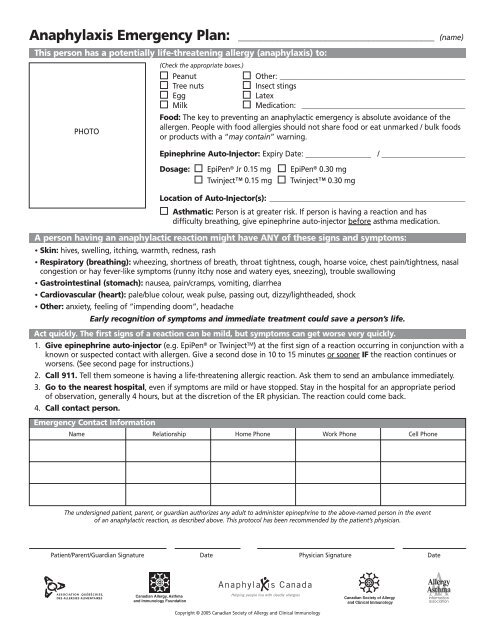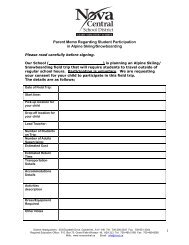Anaphylaxis Emergency Plan - Allergy Safe Communities
Anaphylaxis Emergency Plan - Allergy Safe Communities
Anaphylaxis Emergency Plan - Allergy Safe Communities
You also want an ePaper? Increase the reach of your titles
YUMPU automatically turns print PDFs into web optimized ePapers that Google loves.
<strong>Anaphylaxis</strong> <strong>Emergency</strong> <strong>Plan</strong>: _____________________________________________ (name)This person has a potentially life-threatening allergy (anaphylaxis) to:PHOTO(Check the appropriate boxes.)PeanutOther: ___________________________________________________Tree nutsInsect stingsEggLatexMilkMedication: _____________________________________________Food: The key to preventing an anaphylactic emergency is absolute avoidance of theallergen. People with food allergies should not share food or eat unmarked / bulk foodsor products with a “may contain” warning.Epinephrine Auto-Injector: Expiry Date: __________________ / _______________________Dosage: EpiPen ® Jr 0.15 mg EpiPen ® 0.30 mgTwinject 0.15 mg Twinject 0.30 mgLocation of Auto-Injector(s): ______________________________________________________Asthmatic: Person is at greater risk. If person is having a reaction and hasdifficulty breathing, give epinephrine auto-injector before asthma medication.A person having an anaphylactic reaction might have ANY of these signs and symptoms:Skin: hives, swelling, itching, warmth, redness, rashRespiratory (breathing): wheezing, shortness of breath, throat tightness, cough, hoarse voice, chest pain/tightness, nasalcongestion or hay fever-like symptoms (runny itchy nose and watery eyes, sneezing), trouble swallowingGastrointestinal (stomach): nausea, pain/cramps, vomiting, diarrheaCardiovascular (heart): pale/blue colour, weak pulse, passing out, dizzy/lightheaded, shockOther: anxiety, feeling of “impending doom”, headacheEarly recognition of symptoms and immediate treatment could save a person’s life.Act quickly. The first signs of a reaction can be mild, but symptoms can get worse very quickly.1. Give epinephrine auto-injector (e.g. EpiPen ® or Twinject TM ) at the first sign of a reaction occurring in conjunction with aknown or suspected contact with allergen. Give a second dose in 10 to 15 minutes or sooner IF the reaction continues orworsens. (See second page for instructions.)2. Call 911. Tell them someone is having a life-threatening allergic reaction. Ask them to send an ambulance immediately.3. Go to the nearest hospital, even if symptoms are mild or have stopped. Stay in the hospital for an appropriate periodof observation, generally 4 hours, but at the discretion of the ER physician. The reaction could come back.4. Call contact person.<strong>Emergency</strong> Contact InformationName Relationship Home Phone Work Phone Cell PhoneThe undersigned patient, parent, or guardian authorizes any adult to administer epinephrine to the above-named person in the eventof an anaphylactic reaction, as described above. This protocol has been recommended by the patient’s physician.Patient/Parent/Guardian Signature Date Physician Signature DateCopyright © 2005 Canadian Society of <strong>Allergy</strong> and Clinical Immunology
Distributed in Canada by / distribué au Canada par













